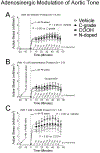Airway Exposure to Modified Multi-walled Carbon Nanotubes Perturbs Cardiovascular Adenosinergic Signaling in Mice
- PMID: 30382549
- PMCID: PMC6470003
- DOI: 10.1007/s12012-018-9487-6
Airway Exposure to Modified Multi-walled Carbon Nanotubes Perturbs Cardiovascular Adenosinergic Signaling in Mice
Abstract
The broad list of commercial applications for multi-walled carbon nanotubes (MWCNT) can be further expanded with the addition of various surface chemistry modifications. For example, standard commercial grade MWCNT (C-grade) can be carboxylated (COOH) or nitrogen-doped (N-doped) to suite specific utilities. We previously reported dose-dependent expansions of cardiac ischemia/reperfusion (I/R) injury, 24 h after intratracheal instillation of C-grade, COOH, or N-doped MWCNT in mice. Here, we have tested the hypothesis that airway exposure to MWCNT perturbs cardiovascular adenosinergic signaling, which could contribute to exacerbation of cardiac I/R injury. 100 µL of Vehicle or identical suspension volumes containing 100 µg of C-grade, COOH, or N-doped MWCNT were instilled into the trachea of CD-1 ICR mice. 1 day later, we measured cyclic adenosine monophosphate (cAMP) concentrations in cardiac tissue and evaluated arterial adenosinergic smooth muscle signaling mechanisms related to nitric oxide synthase (NOS) and cyclooxygenase (COX) in isolated aortic tissue. We also verified cardiac I/R injury expansion and examined both lung histology and bronchoalveolar lavage fluid cellularity in MWCNT exposed mice. Myocardial cAMP concentrations were reduced (p < 0.05) in the C-grade group by 17.4% and N-doped group by 13.7% compared to the Vehicle group. Curve fits to aortic ring 2-Cl-Adenosine concentration responses were significantly greater in the MWCNT groups vs. the Vehicle group. Aortic constrictor responses were more pronounced with NOS inhibition and were abolished with COX inhibition. These findings indicate that addition of functional chemical moieties on the surface of MWCNT may alter the biological responses to exposure by influencing cardiovascular adenosinergic signaling and promoting cardiac injury.
Keywords: Adenosine; Cardiac ischemia/reperfusion injury; Multi-walled carbon nanotubes; cAMP.
Conflict of interest statement
Conflict of Interest:
The authors report no conflicts of interests related to the research reported in this manuscript. The conclusions reported in the manuscript are those of the authors and do not necessarily reflect those of the National Institute of Environment Health Sciences, East Carolina University, Bellarmine University, or the University of Colorado at Denver.
Figures





References
-
- Ayala P, Arenal R, Rummeli M, Rubio A and Pichler T (2010). The doping of carbon nanotubes with nitrogen and their potential applications. Carbon 48: 575–586.
-
- Min C, Zhang Q, Shen C, Liu D, Shen X, Song H, Li S, Xu D, Lin X and Zhang K (2017). Graphene oxide/carboxyl-functionalized multi-walled carbon nanotube hybrids: powerful additives for water-based lubrication. RSC Advances 7: 32574–32580.
Publication types
MeSH terms
Substances
Grants and funding
LinkOut - more resources
Full Text Sources
Medical

